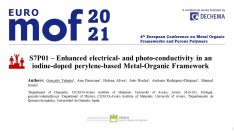resumo
Metal-Organic Frameworks (MOFs) have emerged in the past two decades as promising crystalline porous materials for gas storage and separation, catalysis, sensing, and many other applications [1]. Besides their inherent porosity, MOFs may also incorporate tunable electronic properties (electrical, optical or magnetic) which strongly depend on the selected building blocks, becoming very attractive for their implementation as integral components in electronic devices [2]. In particular, electroactive organic ligands have received much interest due to their tunable electronic properties by molecular design, easy functionalization and possibility to modulate the MOFs electrical conductivity by chemical doping [3]. For example, tunable electrical properties of MOFs based on tetrathiafulvalene [4], pyrene [5], or anthracene [6] ligands have been recently reported, while electrically conductive perylene-based MOFs remain almost unexplored. Herein, we report a detailed study on the electrical properties of a perylene-based MOF exhibiting enhanced conductivity upon iodine doping. In addition, the photoconductive properties of the (non-doped and iodine-doped) perylene-based MOF have been studied.\r\n\r\nReferences:\r\n[1] M. DincÄ, J. Long, Chem. Rev. 120 (2020) 8037; [2] M. D. Allendorf, R. Dong, X. Feng, S. Kaskel, D. Matoga, V. Stavila, Chem. Rev. 120 (2020) 8581. [3] M. Souto, K. Strutynski, M. Melle-Franco and J. Rocha, Chem. Eur. J. 26 (2020) 10912. [4] S. Park, E. Hontz, L. Sun, A. Walsh, T. V. Voorhis, M. DincÄ, J. Am. Chem. Soc. 137, (2015) 1774; J. Castells-Gil et al. Chem. Eur. J. 25 (2019) 12636. [5] S. Goswami et al. Chem. Sci. 9 (2018) 4477. [6] D. Chen, H. Xing, Z. Su, C. Wang, Chem. Commun. 52 (2016) 2019.
autores
Gonçalo Valente, Ana Paracana, Helena Alves, João Rocha, António RodrÃguez-Diéguez, Manuel Souto



